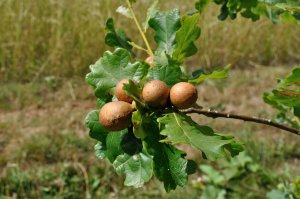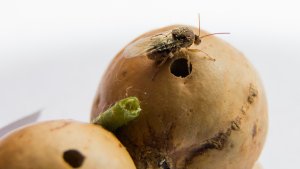The Mysteries of Oak Galls Uncovered
August 9, 2023
By Steve Dishman, Interpreter

The hardy oak tree is one of the most recognizable trees in the world. From its deeply lobed leaves to its strong wood used in all manners of construction, and of course, acorns which are food for animals and fun to collect for people. But have you ever seen an oak tree like the picture above, with strange masses around its branches? The masses are called galls, and galls are abnormal growths you may find on plants or fungi. And they are caused by insects.
Many people may be concerned to see these galls. Does it hurt or kill the oak tree? The short answer is no. Oak galls have been found in many colors and sizes and they are usually formed by wasps or flies. When adult flies or wasps lay the eggs on an oak tree, a strange mass usually forms around the hatching larvae. The gall that forms is in a way like a nursery for the larvae. The plant tissue of the gall provides nourishment for the larvae. It may offer rudimentary protection for the growing insect as well. As the insect matures inside the gall, the gall grows to accommodate it. But when the gall dries out, it will fall off the oak tree, and the fly or wasp will generally fly out of its former home. Oak wilt, a problem across the Eastern half of North America, is not caused by galls, but rather a strain of fungus called Bretziella fagacearum.
There is a rather interesting human use for oak galls that was discovered over a thousand years ago. Gallotannic acid is found inside oak galls and when combined with iron sulfate and a binding agent, generally gum Arabic, the hardened sap of the gum tree, it makes a fine dark purple or black ink. Iron gall ink, as it is called, has been around at least since the 4th Century A.D. The Codex Sinaiticus or Sinai Bible, the earliest complete Bible was written using iron gall ink. It was used by European royalty, Leonardo Da Vinci, and even our Founding Fathers when drafting the Declaration of Independence, Constitution, and Bill of Rights. Its durability was noted for many years, including an official recipe used by the United States Postal Service, but recently, more chemically derived inks have replaced iron gall ink.
Some people may know oak galls by a different name: oak apples. They are the most widely seen gall types and their various colors do mirror apple colors as well from red, yellow, and even green. There are other types of oak galls as well. They include the artichoke gall, marble gall and acorn cap gall. The shape of each gall is determined by the insect laying eggs, the part of the tree found in or even the species of oak tree used.

Oak galls are virtually harmless to trees, except perhaps when a multitude of galls is present on a dying tree. You don’t need to remove them, and truthfully, they can be fun to collect like acorns when they are done providing resources to insect larvae. It is even enjoyable watching wasps and flies utilizing the oak trees. So, the next time you pass an oak tree, see if you can find some galls on it!
